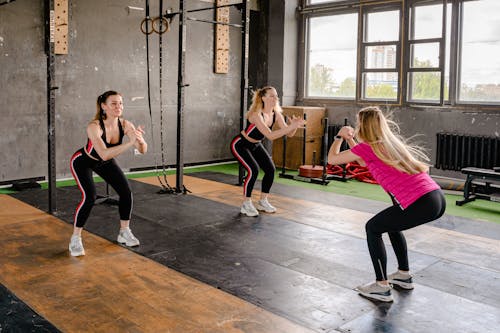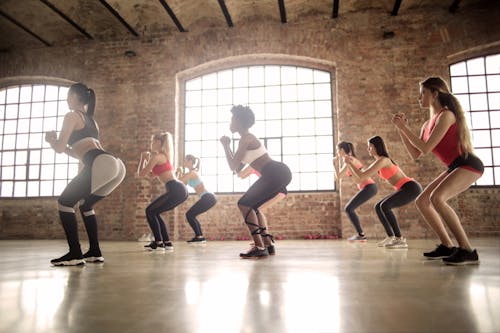
There are many variations when it comes to squats, and different types of squats target different muscles. The key is choosing the right type of squat for your fitness level and building on that variation over time into more challenging versions of the same exercise. Squats are a form of calisthenics and are a functional exercise. The fact that squats are a functional exercise means they can help make everyday activities easier by improving your muscular strength. Whatever your reason for doing squats – to improve strength, tone your body, lose weight, or preserve flexibility, the types of squats below will all deliver results if done consistently:
Split Squat
Single leg squat exercises are fantastic for toning the legs and glutes. The split squat is a single leg squat, and a great way to strengthen and tone your quads and glutes. It involves one leg behind you and elevated off of the ground, focusing your workout on the quadriceps and gluteus maximus as you lower one leg slowly and raise yourself back up.
You can create a more balanced and well-rounded physique by increasing your hip mobility and activating muscles that aren’t worked in a traditional squat. Although great for most fitness levels, this exercise will engage most of your lower body, providing you with an intense workout.
The split squat is more challenging than a regular squat, but you’ll find they get easier as you do them more often.
Sumo Squat (Frog Squat)
One of the most beneficial lower-body exercises you can do, sumo squats are one of the types of squats that put it all on the line. That’s because this compound movement trains all three of the major muscle groups in your legs (quads, glutes, and hamstrings) as well as all four muscles of your core (abs and obliques included) while also improving your hip mobility.
The sumo squat (or frog squat) works best as a combination functional exercise that increases balance, hinges on your ability to resist knee movement by keeping your knees pushed out and improves strength in all of the major muscle groups used to squat deeply.
You’ll stand with a wide stance, your legs are far apart and your toes are pointed outwards. You can hold a kettlebell weight with both your hands as you keep your chest raised, your back straight, and your knees pushed outwards as you squat low like a sumo wrestler.

Wall Squat
The wall squat is an excellent alternative to the traditional squat if you have knee or hip problems. It’s easy on your joints and lets you work on your mobility and flexibility of the legs. The wall squat is one of the best ways to improve your vertical jump.
It’s also ideal for when you don’t have access to a box or bench because it can be done without any equipment at all so that you can do it in your own home in between projects, in the office break room, in waiting rooms, in restaurants – basically anywhere you can find a wall. A wall squat is a great way to strengthen your thighs and quads. By working against the wall, you’ll also be able to focus on good form and prevent yourself from getting too deep into the squat.
Prisoner Squat
The prisoner squat is one of the types of squats used to strengthen and stretch out the quad and glute muscles. You can use it as a warm-up before your workout, as a strength training exercise, or as a way to stretch and loosen stiff legs. It involves putting your hands behind your head, which helps to stabilize the core and shoulder girdle.
By extending your arms behind your head, you altogether avoid using your deltoids, making the exercise perfect for those recovering from rotator cuff injuries or surgery. Everyone can use it, but it’s beneficial for those who have lower back issues because it avoids pressure on the spine.
Side Squat
With a variety of exercises in a routine guaranteed to work in conjunction with each other, the side squat is a great way to work your way to better dynamic balance and agility. Side to side squats will improve your overall performance and agility because they include muscle groups such as the quadriceps, hamstrings, and glutes.
These muscles are responsible for controlling movement and force, which means better coordination and timing for this exercise could lead to better performance in athletic activities such as tennis and golf. The effect of the lateral component in this exercise is enough to produce a significant neural stimulus that will translate into gains in overall speed, explosiveness, power, and quickness.
Pistol Squats
A pistol squat is a challenging lower body exercise that is part of many athletic training programs. A single-leg squat with your back erect, you must stand with your legs straight and have good balance. Your body must be balanced on one leg with no knee or hip bend whatsoever. It is critical to have proper form so as not to injure yourself by performing the pistol squat.
A pistol squat is a single-leg squat where you raise the opposite foot off the floor. It requires strength, balance, and mobility. Pistol squats help you build stronger, more flexible ankles and balance and stability overall. They’re suitable for runners and anyone who regularly makes use of their legs.
Side Kick Squat
Adding kicks to your squats adds a cardio aspect to your strength training. The SideKick squat is a simple, effective movement that you can do anywhere, anytime. It involves a combination of squats as well as lateral kicks, which target the glutes as well as the quadriceps and hamstrings, and engages the cardiovascular system as well, burning calories for rapid fat loss. This is one of the types of squats that when done in succession in multiple repetitions, is a cardio exercise.
From a standing position with feet shoulder-width apart, lower into a squat, with your weight in your heels, making sure your knees don’t extend past the tips of your shoes and your back isn’t hunched over.
Overhead Squat
An overhead squat is a compound, multi-joint movement. It is a squat lift that uses a weight held above your head to strengthen your lower body and core muscles. Practising this exercise will improve your overall stability, core strength, and ability to squat with proper form. It allows you to challenge your hamstring flexibility and grip strength in addition to improving your shoulder mobility.

Jump Squat
Squat jumps mix a squat with a jump and require that you drop down low into a squat position and then use your legs to drive upward as fast as possible to launch yourself into the air. At the peak of your jump, your knees should be straight but not locked, and at the highest point, make sure to land softly on the balls of your feet.
Jump squats help you build strength and increase your speed and explosiveness. This exercise also enables you to boost your cardiovascular endurance, strengthen your legs and bum, and improve mobility.
Find Out Your Optimal Workout and Training Program Based on Your DNA
Squats require a lot of strength, so if you’re genetically prone to having less muscle strength, it just means you have to practice your squats more than other people. Take a CircleDNA test to find out the optimal training program for you, based on your genetic strengths and weaknesses. From here, you can plan out your workout routine and choose the types of exercises that suit you best.

Comments are closed.